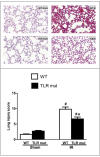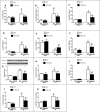Down-regulation of toll-like receptor 4 alleviates intestinal ischemia reperfusion injury and acute lung injury in mice
- PMID: 28099145
- PMCID: PMC5355129
- DOI: 10.18632/oncotarget.14624
Down-regulation of toll-like receptor 4 alleviates intestinal ischemia reperfusion injury and acute lung injury in mice
Abstract
Intestinal ischemia reperfusion (IR) injury is a critical problem, which can cause intestinal injury locally and acute lung injury (ALI) distally by inflammatory responses and oxidative stress. Toll-like receptor 4 (TLR4) is involved in innate immune and inflammatory responses. This study was to determine whether TLR4 mutant can attenuate intestinal and lung injuries after intestinal IR. Wild type (WT) and TLR4 mutant mice were submitted to intestinal IR by occluding the superior mesenteric artery. Histological assessment of the intestine and the lung were conducted by HE staining. The levels of proinflammatory cytokines, oxidative stress markers, apoptotic index and other mediators were measured. In addition, a 24-hour survival study was performed. Histological assessment showed that intestinal IR caused serious injuries in the intestine and the lung, corroborated by increased proinflammatory cytokines in the circulation. TLR4 mutant suppressed the histological injuries as demonstrated by significantly decreased pathological scores. Consistent with the morphological results, the TLR4 mutant mice exhibited remarkably lowered cytokine expressions in the intestine (TNF-α, IL-6, IL-1β, and NF-κB) and the lung (NO, iNOS, MCP-1, MIP-2, NF-κB, and Caspase-3). ALT and creatinine were also significantly dampened in the liver and kidney, respectively. Furthermore, the survival rate over the course of 24 hours was significantly improved. Collectively, the findings reveal that TLR4 mutant significantly abated the intestinal IR injury and ALI at least in part by alleviating the inflammatory response and oxidative stress.
Keywords: Toll-like receptor 4 (TLR4); acute lung injury (ALI); inflammatory response; intestinal ischemia reperfusion (IR); oxidative stress.
Conflict of interest statement
There is no conflicts of interest.
Figures






Similar articles
-
TLR4 mediates lung injury and inflammation in intestinal ischemia-reperfusion.J Surg Res. 2012 May 15;174(2):326-33. doi: 10.1016/j.jss.2010.12.005. Epub 2011 Jan 5. J Surg Res. 2012. PMID: 21392794
-
TLR4-HMGB1-, MyD88- and TRIF-dependent signaling in mouse intestinal ischemia/reperfusion injury.World J Gastroenterol. 2015 Jul 21;21(27):8314-25. doi: 10.3748/wjg.v21.i27.8314. World J Gastroenterol. 2015. PMID: 26217083 Free PMC article.
-
Alpha7 nicotinic acetylcholine receptor activation attenuated intestine-derived acute lung injury.J Surg Res. 2016 Apr;201(2):258-65. doi: 10.1016/j.jss.2015.10.046. Epub 2015 Nov 6. J Surg Res. 2016. PMID: 27020805
-
TLR2 and TLR4 in the brain injury caused by cerebral ischemia and reperfusion.Mediators Inflamm. 2013;2013:124614. doi: 10.1155/2013/124614. Epub 2013 Jun 23. Mediators Inflamm. 2013. PMID: 23864765 Free PMC article. Review.
-
Cellular Signal Transduction Pathways Involved in Acute Lung Injury Induced by Intestinal Ischemia-Reperfusion.Oxid Med Cell Longev. 2021 Jun 4;2021:9985701. doi: 10.1155/2021/9985701. eCollection 2021. Oxid Med Cell Longev. 2021. PMID: 34188755 Free PMC article. Review.
Cited by
-
The effects of different stress on intestinal mucosal barrier and intestinal microecology were discussed based on three typical animal models.Front Cell Infect Microbiol. 2022 Sep 29;12:953474. doi: 10.3389/fcimb.2022.953474. eCollection 2022. Front Cell Infect Microbiol. 2022. PMID: 36250050 Free PMC article. Review.
-
Qingchang Mixture Prevents the Intestinal Ischemia-reperfusion Injury through TLR4/NF-kB Pathway.Comb Chem High Throughput Screen. 2023;26(1):49-57. doi: 10.2174/1386207325666220328090126. Comb Chem High Throughput Screen. 2023. PMID: 35345995
-
Tricky acute mesenteric ischemia: what can we do?Gastroenterol Rep (Oxf). 2025 Jul 7;13:goaf067. doi: 10.1093/gastro/goaf067. eCollection 2025. Gastroenterol Rep (Oxf). 2025. PMID: 40625657 Free PMC article. Review.
-
Modulation of the Oxidative Stress and ICAM-1/TLR4/NF-Κβ Levels by Metformin in Intestinal Ischemia/Reperfusion Injury in Rats.Cell Biochem Biophys. 2025 Feb 26. doi: 10.1007/s12013-025-01687-5. Online ahead of print. Cell Biochem Biophys. 2025. PMID: 40009289
-
Pretreatment with Propofol Reduces Pulmonary Injury in a Pig Model of Intestinal Ischemia-Reperfusion via Suppressing the High-Mobility Group Box 1 Protein (HMGB1)/Toll-Like Receptor 4 (TLR4)/Protein Kinase R (PKR) Signaling Pathway.Med Sci Monit. 2021 May 19;27:e930478. doi: 10.12659/MSM.930478. Med Sci Monit. 2021. PMID: 34010266 Free PMC article.
References
-
- Chen LW, Egan L, Li ZW, Greten FR, Kagnoff MF, Karin M. The two faces of IKK and NF-kappaB inhibition: prevention of systemic inflammation but increased local injury following intestinal ischemia-reperfusion. Nat Med. 2003;9:575–581. - PubMed
-
- Zhi-Yong S, Dong YL, Wang XH. Bacterial translocation and multiple system organ failure in bowel ischemia and reperfusion. J Trauma. 1992;32:148–153. - PubMed
-
- Jensen TH, Heslet L, Fomsgaard A. Translocation and multiple organ failure. [Article in Danish] Ugeskr Laeger. 1993;155:2861–2866. - PubMed
-
- Lane JS, Todd KE, Lewis MP, Gloor B, Ashley SW, Reber HA, McFadden DW, Chandler CF. Interleukin-10 reduces the systemic inflammatory response in a murine model of intestinal ischemia/reperfusion. Surgery. 1997;122:288–294. - PubMed
-
- Schmeling DJ, Caty MG, Oldham KT, Guice KS, Hinshaw DB. Evidence for neutrophil-related acute lung injury after intestinal ischemia-reperfusion. Surgery. 1989;106:195–201. 201–202. - PubMed
MeSH terms
Substances
LinkOut - more resources
Full Text Sources
Other Literature Sources
Research Materials
Miscellaneous

